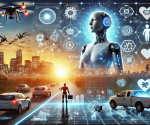The newest cloud computing technology allows quicker, smarter, and safer methods to store, process, and utilize data. Every year, cloud computing brings something new. It is more powerful today because of new tools such as AI, edge computing, and serverless systems. So the latest technology in cloud computing is — a blend of artificial intelligence, serverless computing, and edge-based systems. These assist businesses in accomplishing work more efficiently, less expensively, and better. Now, let us know how cloud technology will be changing by 2025.
Latest Technology in Cloud Computing
Artificial intelligence is reshaping cloud computing. Fast forward to 2025, the cloud computing powered by AI has grown. AI in Cloud Computing Cloud platforms employ AI tools to think and make decisions. They also allow machines to use work that has been done in the past to get better over time. All these adaptive tools utilized now belong to the new era of cloud computing technology.
Filtering of Information with AI Leverage
Cloud systems use big data to know trends, and AI helps find them. This broad paradigm learns data fast and returns results in seconds. AI makes for fewer human errors as well. AI in cloud computing makes it faster and smarter. Big companies use AI to predict problems before they happen.
Cloud services can also use AI models to self-heal, which means less downtime and savings. These models learn how to maintain the health of systems, resolving problems before people encounter them. That is why moAI cloud platforms have started to add AI tools.
Artificial Intelligence and Cloud Security Solutions
Artificial intelligence enables a richer layer of security for the cloud platforms. What each hacker does is attempt to crack cloud security. AI keeps an eye on every network action. It can track down a hacker in seconds. AI warns the security team and takes action before damage is done. And this is how AI aids cloud security solutions.
In 2025, the area that needs most security is the cloud. AI alerts unusual activities, such as bizarre logins or raAId data downloads. Then, it blocks the activity and reports it. This, in turn, renders clouAIdata extremely secure.
Artificial Intelligence and Cloud Automation Tools.
AI supports cloud automation tools as well. These are tools that work autonomously. For instance, they can activate additional servers when users flood an app. Later, they switch off the extra servers when traffic subsides. AI makes this smart and fast. They can also aid in repairing bug problems, upgrading AIps, and transferring data securely.
IT teams find time to be moment-clarifying and benefit solely from login automation. It allows them to zero in on the big data challenges AIile A.I. does the little, everyday tasks. It improves the entire cloud ecosystem.
Artificial Intelligence (AI) and Cloud-Native Applications
Cloud-native apps are where AI shines the best. These applications are designed for the cloud. AI makes these apps superior by introducing intelligent features. A shopping app, for instance, can display better product options by leveraging its AI. This makes the user experience better.
AI-Powered Cloud-native Apps Learn User Behavior To evolve according to what users seek. That makes this evolution more useful and powerful over time.
Serverless Architecture: One of the Latest Technology in Cloud Computing
Serverless architecture is another very familiar cloud computing trend in 2025. It’s transforming the way companies build apps. In Serverless, companies don’t manage servers. The cloud provider executes the code as required. This allows developers to write code instead of optimising managing machines.
What Optimizing Architecture?
Being serverless means you will no longer need to worry about servers. You just write your code. When someone uses it, the cloud runs it. You are billed only for the time your code runs. This saves money. Developers do not have to guess how many servers to deploy. The cloud scales it for them.
Many of the benefits of serverless architectures come with this new working method. It is less expensive, easier, and quicker.
Serverless Enables Cloud-Native Applications
Serverless is a great fit for cloud-native applications. These are applications designed to exist in the cloud. They expand and retract based on user demand. With serverless, these apps can expand rapidly as more and more users come along. When traffic decreases, they shrink back. This allows for controlling cost and performance.
Serverless also facilitates easy feature additions. In particular, The developer can insert small chunks of code without changing the entire app. This makes the updates fast and secure.
Serverless Function Along with Containerization in the Cloud
This means cloud containerization is a big thing in 2025, too. It means putting apps and their configuration into little boxes. These boxes—containers—could run anywhere. Containers and serverless go hand in hand.
A company can utilize serverless functions within a container, for instance. It is fast and takes fewer resources to run. It also simplifies the migration of apps between clouds. It enables a multi-cloud strategy and allows users for more control.
Importance of Edge Computing of Cloud Computing
Cloud growth is now heavily tied to edge computing. Centers not merely data centers in 2025. By implementing edge computing in the cloud, organizations. The result is quicker work, reduced latency, and enhanced performance of AI. With edge computing, we can process data, in real-time, close to the command device, creating it, and providing the best cloud and the best technology.
What is Edge Computing?
Edge computing means doing data processing near the source of data generation. Instead of reloading it to a remote cloud server, the system processes it on the “edge.” For example, a smart city camera can process traffic data locally without sending it to the cloud. This makes the system faster.
Cloud has edge computers that create a faster response for users. The system handles real-time decision-making. This matters in self-driving cars, hospitals and t, he machines that operate factories.
Edge Makes Cloud Better
Edorganizationsge computing makes the cloud more effective. A company gets the best of both clouds and Edge when it utilizes both. It is edge data that needs to work quickly. Data requiring additional storage or further analysis goes to the cloud.
The combination creates so-called hybrid cloud technology. It combines private and public clouds and edge systems. This also gives control but speeds up the process. Businesses prefer this setup as they can get both power and flexibility.
What Does Edge Do?
Many companies are now employing many companies employ a multi-cloud strategy. That is, they are using more than one cloud service. For instance, one for data storage, and another for apps. Edge computing enables this, providing optimal connectivity across clouds. It is what allows data to flow seamlessly between services.
Multi-cloud and Edge enable companies to remain online during a cloud failure. They also avoid being reutilized by a provider. That brings safety and alternatives for businesses.
Edge Optimization of the Future of Cloud Computing
Cloud computing will involve more edge setups moving forward. Edge will be used in smart homes, societies, and smart machines. They will require fast cloud services that are nearby them. So Edge and cloud will grow hand in glove.
That shift also decreases the stress on cloud data centres. This saves money and emergent also helps cloud-native applications for working with low delay. This helps cloud apps become smarter and faster.
Cloud and Quantum Computing and Serverless
This is future tech , quantum computing, and cloud computing. It uses superfast computers capable of solving large problems. Quantum apps test in the cloud with serverless tools. This allows developers to run quantum tasks only when needed. And they do not spend unnecessary resources like that.
Quantum systems are still young, but the pace of containing neritic orange is blistering. Quantum power will be easy to use with serverless tools on the cloud.
Relevance to ACCA Syllabus
Cloud computing is directly related to the digital transformation of accounting. The ACCA representation is showing increasing interest in how finance systems interface with cloud platforms. They are key to performance management, audit, and assurance documents. The new accounting system is a cloud system so having ACCA candidates the understanding of cloud as a system to be added on to the accounting system provides them a much better view in evaluating the accounting system, they can see cloud as a risk, as an area within their internal control and an adequacy for reporting in their view is key as they will see how the process runs.
Latest Technology in Cloud Computing ACCA Questions
Q1: How does cloud-based accounting system benefit the financial reporting?
Manual transaction processing
B) Availability of data In real-time
C) Limited user access
D) More physical storage space needed
Ans: B) Real-time data availability
Q2: What ACCA subject is cloud computing considered to internal controls and audit?
A) Financial Management
B) Taxation
C) Audit and Assurance
D) Corporate and Business Law
Ans: C) Audit and Assurance
Q3: What serious risk is posed by using machines in the cloud that handle money-related info?
A) Reduced hardware cost
B) Easy scalability
C) Cybersecurity threats
D) Better collaboration
Ans: C) Cybersecurity threats
Q4: With regards to management accounting, how does cloud technology play a role?
A) To manufacturer of hardcover ledger books
B) Through actionable reporting and predictive tools
C) By erasing financial records
D) Making the data on costs less transparent.
Q: How can I run accurate credit queries in real-time on the credit card?
Q5: What is a combination of finance, HR, and analytics cloud software called?
A) Legacy ERP
B) Core Banking
C) Integrated Cloud ERP
D) On-premise system
Ans: C) Integrated Cloud ERP
Relevance to CMA Syllabus
US CMA — Strategic Cost Management and Decision Analysis Content Area Digital finance evolution is largely driven by the cloud computing system. Data up to October 2023 You need to know how cloud tools simplify cost tracking, budgeting, and real-time evaluation of a business’s performance to be a CMA candidate. Integration of the right technology is also very critical to enterprise-wide financial crossings.
Latest Technology In Cloud Computing CMA Questions
Q1: In terms of cost accounting, what are the advantages of cloud platform in general?
A) Delayed budget reports
B) Static dashboards
C) Sharing real time data across departments
D) Manual spreadsheet updates
Ans: C) Real-time Data Sharing across the Departments
Q2: What CMA part covers cloud computing the most?
A) Analysis of Financial Statement
B) Strategic Management
C) Technology and Analytics
D) Reporting Financial Results to Third Parties
Que: Data Science and Machine Learning go hand in hand with __.Ans: C) Technology and Analytics
Q3: Which cloud product can be used to track CMA related performance metrics?
A) Slow data sync
B) Offline data storage
C) Live dashboards and KPIs
D) Printed reports only
Ans:C) Live Dashboards & KPIs
Q4: What cloud technology trend makes CMA planning and forecasting functions better?
A) Manual calculation
Integration with the Artificial Intelligence
C) Ledger book maintenance
D) Paper-based workflow
Ans: Artificial Intelligence (B)
Q5: Which part of a management accountant’s role does cloud computing complement?
A) Scratchings in a pencil journal
B) Cost reports and scenario analysis automation
C) Filing paper tax returns
D) Internal legal case review
Ans: B) Automated cost reporting and scenario analysis
Relevance to US CPA Syllabus
Clouding concepts have been integrated into US CPA exam topics on, e.g., audit technology, accounting systems, IT governance, system controls, etc., which is good, and because cloud platforms significantly alter the data integrity and audit trail and the access to the system controls, CPAs should reflect on their impact. When used in the real world, external cloud tools support ethical reporting and compliance.
Latest Technology In Cloud Computing US CPA Questions
Q1 — What features of cloud computing enable auditors to evaluate transactions with higher efficiency?
A) Physical backup folders
B) Manual voucher entry
C) Automated audit trails
D) Paper printouts
Ans: Automated audit trails (Option C)
Q2: Which section of the CPA exam does cloud computing most directly apply to?
A) Management Environment and Principles
B) Regulation
C) Auditing and Attestation
D) Ethics and Law
Ans: C) Auditing and Attestation
Q3. What risk of concern to accounting owners when considering using cloud platforms?
A) Lack of mobility
B) Data encryption breaches
C) Decreased collaboration
D) Fewer updates
Ans: B) loopholes in data encryption
Q4: How do cloud computing solutions aid financial accounting☆
A) Delayed updates
B) Static journal posting
C) Real-time entries from multiple users
D) Limited user tracking
Ans: C) Access by multiple users and real-time entries
Q5: What control ensures integrity of cloud-based data at audits?
A) VPN disconnection
B) Action logs and access and activity tracking
C) Disabling user access logs
D) Printing every file
Ans: (B) Access & activities logs
Relevance to CFA Syllabus
That’s already part of the CFA exam: fintech—for instance, cloud technology—is incorporated into the portfolio management, ethical and risk management components of what the CFA encompasses. CFAs need a grasp on how data lives in the cloud and how AI-driven tools also in the cloud can change the way investments are analyzed, models are built and risk is forecasted. Provides analytical capabilities through scalable platforms.
Latest Technology In Cloud Computing CFA Questions
Q1: What kind of cloud features work best for Investment Analysts?
A) Manual spreadsheet uploads
B) Live market data based on data
C) Delayed data entry
D) Static portfolio reports
ANS: B) In real-time market data feeds
Q2: What trends regarding cloud and data tech does CFA curriculum cover?
A) Quantitative Methods
B) Ethical Standards
C) Investment Management Focused Fintechs
D) Corporate Issuers
Ans: C) Investment Management Fintech
Q3: What is the role of cloud platform technology in managing algorithmic portfolios?
A) Manual report coding
B) AI and ML
C) Fax-based trading reports
D) Analog storage
Ans: B) AI & ML
Q4: But before we get into the why: Cloud technology comes with certain risks and that can impact investment platforms.
A) No data logging
B) Instant file printing
Cyber [Security] & Data Breach (C)
D) Reduced collaboration
Ans: Cyber Security and also Data Breach
Q5: Which property of the cloud systems makes the portfolio simulation scalable?
A) Fixed server setups
B) All in One Computation and Storage
C) Flash drives
D) Non-digital charts
Q: What is the key feature of Google Cloud?Ans: B) Elastic computing and storage


